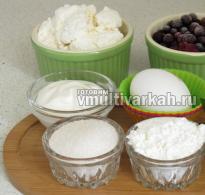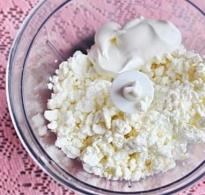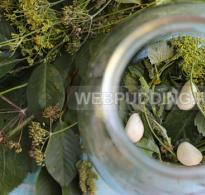Why does bread get moldy? How to properly store bread? How to store bread correctly: simple tips for diligent housewives.
Bread should always be at home. Guided by this rule, people sometimes buy more loaves and rolls than they need. What to do with the "main product", which turned out to be unclaimed? The hand does not rise to throw it away.
There are two ways to solve the problem. Learn how to store bread and bakery products so that they stay fresh for a long time. And if they still stale - also put into action.
Bread box - a traditional way of storing
So what is the right way to store bread? Much depends on which varieties you prefer:
- Someone takes the loaves in the store - they are often already cut and packed in plastic.
- Others buy pastries from kiosks - while they are hot.
- Still others have purchased a bread machine and bake at home.
But there is general rules storage of bread at home, which should be followed.
For bakery products it is necessary to create special conditions. Many housewives purchased bread bins - made of plastic, metal, wood. If you do not know what to give your friends, such a thing will be a good gift.
- Plastic bread box is lightweight, inexpensive, and easy to clean. However, it is short lived.
- Metal will serve you for many years. She is also easy to care for.
- But the most the best option- wooden. Where can you buy one? Most often at the market, at the masters.
There is only one "but". After washing the wooden bread box, dry it so that it does not become damp.
Note to the owner
Flaming (burning) can be used instead of washing a wooden bread box. Soak a cotton swab in ethyl (medical) alcohol and set fire to the cotton wool right in the bread box, covering the lid. Fire is the enemy of fungi and bacteria.

Especially long loaves will be stored in a bread box made of juniper
Why is bread moldy in the breadbasket?
Most likely, the raw materials for baking were of poor quality and already contained mold spores. Once in a favorable environment in your kitchen, where it is warm and humid, these spores have grown "violent color". Or the mold remained in the bread box after you threw out the previous spoiled loaf from it.
- If mold occurs regularly, ventilate the room where the bread box is located more often and wash it every time before putting in a fresh bun.
- If bread of the same variety of a certain manufacturer is moldy, simply refuse to buy it.
Secrets of long storage
- Before putting it away for storage, wrap the loaf in a clean cloth or in a plastic bag, after puncturing holes in it. Air must have free access to the loaf, otherwise mold will appear.
- If you store baked goods in large pots with lids, also wrap them in cotton cloth or put them in a bag.
- A cotton napkin or towel that you wrap flour products, wash with laundry soap or other detergent without fragrance. You don't want your buns to smell like laundry detergent, do you?
- Hardware stores often sell special bags. They have three layers. The outer and inner are fabric, and in the middle is a layer of plastic. When stored in such a bag, the bread can remain soft for 4-5 days.
- The bag can be sewn on its own, and then soaked in a strong solution (2 tablespoons per liter) and dried without rinsing.

Special bag - alternative way storage
Little tricks
If you put a piece or a handful of salt wrapped in cheesecloth in a bread box or in a pan, the bread will stay fresh longer.
Storage location - refrigerator
How to store bread in the refrigerator, and is it possible to do this at all? You can, but again, you need to know the rules.
If the baked goods you want to keep on long term, cut them into slices, pack them in plastic and put them in the freezer. Then you can get a few pieces when you need them. At room temperature they will quickly become soft.
The rules for storing bread in the refrigerator depend on where you put it:
- Bread can be stored in the freezer for several months.
- If you put it on the top shelf of the refrigerator, the period will be reduced to 2-3 days. And then, if the products of the bakery will be packed in plastic.
The temperature in the chamber fluctuates between 0-5 °С. It is under these conditions that the shelf life decreases and flour products stale the fastest. This is why it is believed that bread should not be stored in the refrigerator. Bread will not mold in the refrigerator, even if the raw material contains a fungus.
Tip of the day
When using the loaf, cut it in half. And then cut off the slices from the middle. When removing the remaining bread for storage, press the slices of the two halves to each other. Then the inside of the loaf will not stale longer.
Black and white - together or apart?
Now let's talk about varieties. Black and white bread should be stored separately from each other:
- First, they have different humidity.
- Secondly, "nigella" has a stronger smell, which will definitely pass to white rolls if they lie together.

The opinion that black bread is healthier than white bread is not true. It all depends on the individual reaction of the body to a particular variety.
Loaves and "slicing" bought in the store are bread with a long shelf life due to special additives. If you prefer hot pastries from a local factory or you bake yourself, do not put the loaf in a plastic bag until it has completely cooled down. The moisture that will be released during the cooling process will cause the carpet to become moldy.
Homebaked bread subject to storage rules, it will be usable for 8-10 days.
Do you know that…
If some piece of bread began to deteriorate, moldy - you can’t let this matter go by itself. It should be thrown away immediately so that it does not “contaminate” other flour products.
The second life of the loaf
What to do if the bread is still stale:
- “Second life” can be breathed into it by slightly moistening with water and holding for 1-2 minutes in the oven at a temperature of 40-50 ° C.
- You can moisten a stale loaf with sweetened water with vanilla, after the microwave you will eat a pleasant, fresh muffin.
- You can also use " water bath". Pour some water into a large saucepan and put on fire. Place the bread in a colander so that moist steam envelops it, cover with a lid. After a few minutes, the loaf will become soft. The taste of fresh baking will not return, but it will turn out quite edible.

Dried bread with a number of diseases gastrointestinal tract preferably fresh. It is also useful for those who are on a diet.
We answer the question: Why does bread go stale so quickly?
Can delay the crystallization process protein products added to :
- With high content squirrel;
- a handful of crackers with broth - here you have croutons. Such croutons can also be thrown into a frying pan with scrambled eggs.
In the culinary literature you will find many descriptions of dishes using stale bread From casseroles to desserts. There are also videos on this topic:
Now you know the secrets of saving bread and baked goods, how to store them in the refrigerator, and that bread can be frozen. However, this product is intended for quick consumption. Therefore, try to buy bread in moderation.
Store properly and be healthy!
Have you read the article? Please give feedback:
- Rate the article and share with your friends on social networks if it was useful and you learned something new.
- Supplement the material by writing a comment if you have your own experience in storage or disagree with something.
- Ask a question to our specialist by clicking the button below and get a qualified answer if you did not find it in the text.
Thanks in advance! It is important for us to understand that we are not working in vain.
You have seen it all. You forget a loaf of bread in a bread box or bag, and after a few days you start noticing blue, green and black fluff growing on the surface of the bread. Mold is a common problem. Why does bread get moldy? The answer lies in understanding what mold is, where it is, and how it lives.
What is mold?
Mold is a representative of the kingdom of fungi, which is separate in the classification of plants and animals. Ordinary edible mushrooms also fall into this category. These are organisms that do not require chlorophyll, so they do not get energy directly from the sun. This means that fungi must use plants and animals as a food source. This is why bread comes with mold: because of the ingredients in its composition, it is an excellent source of nutrition for many types of mushrooms.
How does she get into our house?
Mold gets on bread through airborne spores. Although you cannot see them, there are millions of them around you.
These spores can accumulate in the dust around your home, which is kicked up by sweeping, the wind, or just a person passing by. Spores can enter your home, settle on bread, and the mold process will start. Mold lives and feeds on bread. That's why she can quickly cover the whole loaf if she is allowed to. Mold multiplies at a high rate - sometimes it can double in size within an hour.

What is mold?
Penicillin is the first antibiotic created from mushrooms penicillium chrysogenum, and this discovery belongs to Alexander Fleming, the great scientist. It is contained in noble blue cheeses and very beneficial for the body. But not all mold is useful. She comes in different colors.
Black most often covers old bread. Greenish-blue - cheese. Green fuzz usually spreads on oranges that are too long in a humid environment. Mushrooms are a great boon for humanity. Without yeast, there would be no bread or beer. Mushrooms are used to make antibiotics, soy sauce, miso, sake, tofu, and many other products.
On the other hand, many plant diseases that ended in death for them are caused by mold. The Irish famine was caused by potato blight. Most of the great American chestnut forests have been destroyed in 50 years by a fungus introduced into the United States on a tree planted in a botanical garden. Mushrooms are responsible for trillions of dollars of food damage every year around the world.

Is mold a plant or a fungus?
Have you ever opened a loaf of bread that was in the kitchen for a long time and saw dark spots? This is mold. What happens when you leave the bread open for a while longer? Mold spreads quickly and all bread turns green or black and looks very unappetizing.
But mold is a simple fungus that takes for its growth and reproduction nutrients from bread and damage its surface. Mold grows on bread from microscopic fungi belonging to various types. She happens different forms and flowers depending on the species.
Rhizopus stolonifer (black mold) - the most common on bread, which, moreover, grows very quickly. It also causes fruit rot and some infections in humans. Microscopic pieces of moldy bread, known as spores, float around in the air around us. They can be found on any surface and in any conditions. It is the spores that sit on the surface of the bread, which can be left open in normal conditions let's say in the kitchen. They germinate, form colonies, which begin to grow on the surface of the bread, absorbing all the moisture and nutrients from it. The growth rate of bread mold depends on several factors, and the ambient temperature is the most important of them.
Causes of mold growth and ways to slow it down
Mold growth will slow down if the bread is kept refrigerated. It should be noted that most molds thrive at temperatures above 70°C, and low refrigerator temperatures are unfavorable for mold. Put a slice of bread in the freezer and mold growth will stop completely until the temperature rises to a favorable level.
Why does bread get moldy? Bread mold is a living organism that requires moisture and oxygen to grow. The moisture in the plastic bag allows the fungus to grow at a faster rate. However, since it is considered a fungus and not a plant, it does not require sunlight to increase or decrease its growth rate.

Let's conduct an experiment and find out how and why bread becomes moldy
We will need:
- fresh bread from the bakery;
- cotton pad;
- pipette;
- water;
- plastic bag;
- scotch;
- an empty milk carton;
- disposable gloves.
Experiment:
- Gather some dust from the ground with a small cotton pad.
- Rub it on a slice of fresh bread.
- Using an eyedropper, place five to six drops of water on a slice of bread.
- Put it in a plastic bag and seal.
- Now place this sealed bag of bread in an empty milk carton.
- Close the box tightly with tape.
- Leave the box alone for two days.
What do you observe when you open the package two days later? The bread is completely covered with fluffy black or greenish spots. Why does bread get moldy? The dust that was placed on the bread carried fungus spores, which led to the growth of mold on it.

Mold Prevention
- Why does bread mold quickly? Moisture promotes faster mold growth. Therefore, do not store bread in a humid environment. It is best to leave it in the same bag in which you brought it from the bakery.
- Why does bread from the store get moldy? Most likely, it contains fats or old bread was used in its preparation. If you are making bread at home, use ingredients that are fat-free and not butter, eggs, milk, etc. This will keep the bread fresh for longer. long term.
- A bread box is another option for storing bread for a long time. Choices of wood, clay, and metal bread bins are best for storing bread, as they can keep it dry and don't accumulate moisture.
- Why does sourdough bread get moldy? Most likely because it was packaged too hot or the bun was too big.
- Never store bread at room temperature or in the refrigerator for an extended period. Freezing will be helpful if required long-term storage.
- To keep the bread summer time, requires some additional effort. Do not store bread in a plastic sealed container, and if you have a homemade or sliced loaf, wrap it in wax paper and place it in Plastic container with tight-fitting lid.
- And finally, try to eat bread and other similar products as fresh as possible. If you see mold just appearing on food, don't try to cut it out and then eat the product. Remember that the mold has already sprouted from the inside.
- Why doesn't Borodino bread grow moldy? Its acidity is higher than that of ordinary, and this does not allow mold to grow.

Harm of mold to humans
Moldy bread contains spores and should therefore not be handled with bare hands. Remember: bread mold is a real poison! Having consumed such bread, an adult can get poisoned, and a child can end up in intensive care. At frequent use bread with mold can develop asthma, allergies, or even oncology.
In case of mold poisoning, the following symptoms may occur: dizziness, nausea and vomiting, headaches, diarrhea. Black mold is considered especially dangerous. Symptoms are similar to colds, so they may not immediately alert a person. And at this time, the body is already poisoned, and the patient's condition worsens: pressure jumps, breathing problems, headaches appear. In any such situation, you should immediately seek medical help.
Well, everyone is familiar with this feeling: you hold warm, crispy, fragrant freshly baked bread in your hands, thus enjoying not only the taste, but also the smell and sound! And then suddenly you look into the bread box, and a layer of mold has formed on the crispy pink salmon. But the bread box is clean, and the bread is fresh! ...
I am sure that I was not the only one who faced how the bread was covered with mold. This time I wanted to find out why. Googling on the internet and doing my own experiments, I think I got to the bottom of the truth.
It turned out that there can be several reasons for the appearance of mold on bread. The first of them is this: malicious producers (be it wrong!), not wanting to reduce their profits, put into circulation low-quality products that already contain mold in the manufacture of bread! By the way, those acquaintances who cut off the crust and eat the crumb are probably now coming to mind, being in full confidence that they have secured their health. Yeah of course!...
By the way, if suddenly someone did not know, mold spores fly everywhere and everywhere, and getting on our crispy, hot bread are starting to multiply. The toxins released at the same time are unrealistically harmful and dangerous, so you have to part with the whole loaf. By the way, when high temperature Mold grows at an even faster rate! So your bread box should be removed away, say, from the stove.
But since mold will also find something to profit from in a humid environment, we are looking for a dry place for our breadbasket. I rashly hid the bread in a plastic bag, and, of course, I was disappointed again: due to poor ventilation, the mold was already waiting for me there.
After reading a few articles, I decided to trust the experts and put the bread in the refrigerator. As long as he lives. Although no! It would be more correct to say that nothing lives in it! And appearance the bread is pleasant and tastes good. And on the edge of the bread box, on the advice of my friend, I sprinkled a pinch of salt, it seems that the excess moisture “leaves”. Some housewives advise me to grease the surface of the bread box ethyl alcohol or sorbic acid, but I just decided not to buy for the future, I won’t have to stand in line with shopping bags, I hope you can buy fresh pastries every day.
And finally, I will say that I switched to rye bread. because of hyperacidity(don't be afraid, it's not more acidic) it's less prone to mold. Well, it’s better to cut the bread yourself, who knows them there, these manufacturers, maybe they still don’t disinfect the cutting surfaces when cutting!
What kind of bread do you eat? Or has it been completely abandoned?
“Bread is the head of everything” is an old folk saying. Each of us knows how pleasant the aroma of freshly baked bread is, but the trouble is that this product very often starts to mold quickly. What's going on and why is bread moldy, especially store?
Why is bread moldy
How does bread molding happen?
First of all, you need to figure out what happens to the bread during the molding process. And this is what happens to him. Being in a warm and humid environment, bread is most susceptible to infection by moldy fungi that are in the air.
Once on the surface of the bread, they begin to actively multiply and secrete mycotoxins. First, the moldy fungus affects the surface of the roll, especially accumulating in places of cracks, and then through these same cracks it begins to penetrate deeper and deeper into the bread. That is why such bread should not be eaten, even if outwardly the fungal lesions are visible only on the crust. The fact is that moldy fungus has type of mycelium, that is, long threads that are practically invisible to the human eye, penetrating to a great depth inside the bread.
Why does bread get moldy?
The reasons for moldy bread are different - this is mainly due to improper storage, but recently, poor-quality raw materials for baking have become increasingly to blame.
Incorrect storage.
It is not recommended to store bread in a warm room where the air temperature reaches +25 - (+30) C, and besides, it is also high, about 70-80% humidity. Such conditions are the most favorable for the reproduction of moldy fungus. It is also not necessary to store bread in a tightly wrapped plastic bag, as it can “sweat” and as a result of this, high humidity will be established in the bag, which again will lead to infection of the bread with mold.
The best way to store bread tightly closed in ordinary wooden bread bins, which should always be in a perfectly clean condition. Sometimes, if you want to leave the bread for a long time, then to protect it from mold, its surface is smeared with ethyl alcohol or sorbic acid. However, do not do this too often, just as you do not need to buy bread for future use - it is best to buy fresh pastries every day.
Poor quality raw materials.
Very often, bread producers, in order to increase the profitability of production, begin to save on raw materials. So, for example, bread baked from low-quality, low-grade flour more prone to mold than the one that was baked according to all the rules and standards. Sometimes in the composition of bread you can find various chemical additives and even mashed potatoes(naturally, not real, but powdered) - all this leads to the fact that the quality of the product is noticeably reduced, and therefore, such bread crumbles a lot and becomes moldy much faster. Unfortunately, this is practically impossible to avoid and very difficult to control, so the only way out of the situation is to completely abandon purchased bread and cooking fresh pastries at home on your own. If you are not satisfied with this option and there is a catastrophic lack of time or patience to bake homemade bread, then at least do not buy store baked goods for the future for a long time, but rather buy it as it ends. By the way, it should be noted that rye bread keeps much longer than white wheat. The reason for this is its high acidity.
Now you know why bread is moldy, and you will probably try to avoid situations that provoke this unpleasant process. After all, moldy bread not only acquires an unpleasant taste and smell, but also becomes a source of toxic substances. Scientists have long established that mold is one of the provocateurs for the development of cancer cells, so do not risk your health and do not eat a spoiled product.
19.06.2016 13:23
It often happens that freshly bought bread becomes moldy almost instantly. It would seem that you just bought it yesterday, and today a muck with a characteristic smell has already appeared on it.
At first, this is upsetting - especially if you are already standing with pieces of cheese and sausage, because you had the intention of making yourself delicious sandwich. Then, when this is repeated from time to time, it begins to irritate and annoy and causes bewilderment. Still - who likes to see mold on bread a couple of times a week, send bread to the trash and think about money thrown to the wind?
100 Worlds will help you figure out why bread gets moldy so quickly and what to do in such an annoying situation.
The occurrence of mold and its danger
Of course, you have a logical question - where does the mold on bread come from, and even in such quantities? After all, you live in a cozy house, and not in a damp and unsightly place.
In fact, mold spores fly almost everywhere in the air, and, accordingly, settle on objects and products. The grains of mold are very small, and therefore they are invisible to the human eye. Mold on bread becomes noticeable only when the spores have already developed and multiplied, and this will happen if the product gets into favorable conditions for fungi.
Many people think that if the mold has affected only the crust of bread, then this is not a problem - you can cut it off and eat the intact part of the piece of bread. In fact, it is not recommended to do this - such mold is a serious toxin that, when it enters the body, poisons it. And if mold appeared on the crust, this means that in fact all the bread is already infected with a fungus that has already begun to actively develop in the bread crumb. And therefore, if the mold has affected the bread, then it should be thrown out entirely, without regret.
Why does bread mold quickly and how to deal with it?
! Nowadays, there are often unscrupulous manufacturers who save on the quality of raw materials and neglect sanitary standards. Thus, consumers often buy already contaminated bread in the store. By the way, the conditions for storing bread in stores are also different. Sometimes, having bought seemingly fresh bread, you may find that the pieces in the bag are slightly damp. This means that the bread contains excess moisture, which is likely to cause the bread to mold quickly. Thus, try to be careful about the choice of the bread manufacturer, as well as the store where you buy the bread.
And, of course, if you have the desire and opportunity to buy a bread machine, then it is better to do it. Homemade bread that you made yourself will last longer than store-bought bread made by a manufacturer whose purity of conscience is questionable.
! Favorable conditions for the growth, development and spread of harmful mold bacteria are heat and humidity. Therefore, make sure that in the breadbasket and in the kitchen, in principle, there are no such conditions. Bread is usually stored in the kitchen, and the kitchen is both heat from the stove and steam from boiling water. Accordingly, try to ventilate the room more often and monitor the condition of the bread box.
! By the way, about the bakery. Do not allow harmful bacteria to settle and multiply in the place where the bread is stored. Therefore, keep the breadbasket clean and disinfect it once a week by wiping it with ethyl alcohol. In addition, it is better to pour a little salt into the corner of the bread box - it will absorb excess moisture. And it will be better if you get a wooden bread box, not a plastic one.
! Even though air is a source of bacteria, bread needs to be ventilated. Of course, it is not worth keeping it completely open - left in the air, the bread will quickly become stale. However, do not store bread in a tightly tied bag - it will be better if there is a small hole in it for air. A tied bag is a favorable environment for bacterial growth, and in such conditions, bread often molds quickly.
! Bread is traditionally stored in a bread box somewhere on the kitchen table. However, if bread quickly becomes moldy in your apartment, then you can try storing it in the refrigerator - then the mold will not affect this product for a long time.
And a couple more interesting facts about mold on bread:
The speed of mold on bread depends on the level of its acidity: the higher the acidity, the slower the process of mold development. Different types breads differ in their composition, and the rate of development of mold spores is also different for them. So take note that:
√ Rye bread lasts longer than wheat.
√ White bread moldy faster than black.
That, in fact, is all you need to know if bread molds very quickly in your kitchen. Yummy sandwiches!
Anastasia Cherkasova,
Women's Internet magazine "100 Worlds"
Love to eat sandwiches? Then you should take a look at Snacks - You can find delicious recipes there!






